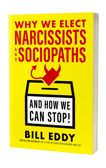The news today is filled with the crises and consequences of high-conflict leaders, most of them self-inflicted. High-conflict leaders increase conflicts instead of calming or resolving them, distracting themselves and others with drama and false heroics instead of real problem-solving. To name a few, there was the fall of Theranos founder Elizabeth Holmes, Uber’s founder Travis Kalanick, and hedge fund/pharma chief Martin Shkreli, and others are sure to follow. But we’ve also witnessed the rise of authoritarian political leaders, like Venezuela’s Nicolas Maduro, Brazil’s Jair Bolsonaro, Vladimir Putin, and Kim Jong-un.
What are the contributing factors that thread through all of these high-conflict leaders, and what is it about our current social and political climate that emboldens these types of leaders when we know so much about alternative forms of leadership, such as positive leadership or servant leadership?
What is a High-Conflict Personality?
I’ve been writing and teaching about how to deal with high-conflict personalities in interpersonal conflicts and legal disputes for the past fifteen years from the perspective of a therapist, lawyer, and mediator. With this background, supported by research and on-the-ground work, the worlds of politics and business demand a deeper and critical analysis of what contributes to the rise of high-conflict leaders.
There’s a common pattern across all of these cases: One or more “high-conflict” people (HCPs) who have certain personality characteristics. These include the following:
- Preoccupation with blaming others—their “targets of blame”
- All-or-nothing thinking—and solutions
- Unmanaged or intense emotions—which constantly throw them off-course
- Extreme behaviors—which 90% of people would never do.
Another perhaps surprising characteristic of HCPs is that they also tend to have the traits of one or more personality disorders. These disorders involve a mental health diagnosis that essentially indicates the person has (1) impaired interpersonal relationships, (2) does not reflect on his/her own behavior, and (3) does not change, even when it is obvious to everyone else that he/she should. Of course, some of these personality disorders cause social impairment and internal distress for the person who suffers from them. However, some personality disorders, such as narcissistic, antisocial, borderline, histrionic, and paranoid, tend to cause a great deal of intense and prolonged conflict with those around them. Thus, many (but not all) are “high-conflict.”
Mental health research suggests that 15% of adults in the United States have a personality disorder. However, not all of these people show the signs of having all 4 attributes of high-conflict personalities, and not all people with high-conflict personalities have personality disorders. Knowing this, I estimate that about 10% of adults are likely HCPs. You might even know a few of them—but don’t tell them you think that, as you may become their new Target of Blame.
Put simply: Once you’ve identified that you work for HCPs, think it to yourself and adapt how you interact with them.
Narcissists and Sociopaths as Leaders
When high-conflict people (HCPs) want to become leaders, they tend to have traits of narcissistic personality disorder or antisocial personality disorder, also known as sociopathic. Narcissistic people, because they are driven to prove that they are superior, have fantasies of unlimited success and power, have grandiose ideas, and lack empathy. The antisocial traits they exhibit, because they are driven to dominate others, translate into being highly deceitful (lying and conning), highly aggressive (and risk-taking), and lacking remorse for hurting others (worse yet, they sometimes enjoy it).
While these characteristics make them sound completely negative, they also are the two most seductive personalities on the planet. Narcissists sweep people off their feet with their intense charm, confidence, and pie-in-the-sky plans, which is true of how they secure influence and control, from dating to gaining investors. If nothing else, they singularly believe in their superiority and success.
Sociopaths (antisocials), on the other hand, know that they are constantly lying, but they don’t care. They too can charm dates and investors with totally false information without batting an eyelash. Some people have traits of both of these personality disorders. Many have said that Bernie Madoff was such a person, as well as Ted Bundy, and possibly Lance Armstrong and OJ Simpson. And of course, throughout history, we have had dozens of these high-conflict leaders including Hitler, Stalin, Mao, Pol Pot, and Idi Amin, on up to Vladimir Putin and Kim Jung-Un.
Why Now?
In my book, Why We Elect Narcissists and Sociopaths—And How We Can Stop!, I detail why we are seeing more high-conflict leaders in business and politics and in organizations of all sizes across sectors. This is a trend that will continue and grow until enough decision-makers, from boards of directors to everyday voters, recognize these personality patterns and intervene.
Here are three reasons why this is happening now:
1. High-Emotion Media Competition
From 24/7 cable news to Facebook and Twitter to endless TV shows and movies on demand, intense competition to monopolize viewers’ viewing time has grown over the past thirty years. This means showing more and more extreme behavior to “beat out the other guys.” As such, high-conflict behavior is becoming more common and, therefore, worryingly normalized.
While this is entertaining for adults, it functions as training for children. Personality development includes absorbing some characteristics of our culture as well as our early childhood and genetic tendencies. Over the past thirty years, our global society has become more narcissistic and sociopathic—due largely to the cultural images on our screens. And the most compelling and influential leaders on the screen are HCPs who are skilled at creating conflict, crises, chaos, and fear—which is what happens to sell the most in the media.
2. Fantasy Crisis Triad
In this modern media cultural landscape, urgent, complex problems with equally complex solutions are oversimplified: terrible crises are caused by evil villains requiring superheroes to vanquish the evil. Of course, the problems do cause real harm and include broken immigration systems, drug abuse, domestic violence, automation, underemployment, income inequality, and climate change. Yet promoting fantasy crises, fantasy villains, and fantasy heroes, however seductive they are, is not the answer.
Years of being presented with fantasy crisis triads have seduced us into believing that there are attractive heroes who should be appointed as leaders when, in reality, they lack leadership skills. However, these high-conflict leaders have skills for getting attention and looking like heroes, so they gather investors, get great press coverage, and lead their organizations to the edge of a cliff or over the cliff. On the other hand, the average person is now looking more and more for a charismatic leader in business and in politics.
3. Always Adversarial Leaders
These high-conflict leaders tend to be always adversarial. While this plays well in the media, with endless panels, debates, and combative pundits, it doesn’t work well in real life. We have spent the last thousand years shifting from kings to constitutions and collaboration with good reason, as I describe in my new book. The chart below illustrates the stark contrast between the old adversarial leadership styles versus modern collaborative approaches. The old style is unsustainable in our new world of science, interdependence, and modern weapons of mass destruction.
Old v. New Leadership: Always Adversarial & Modern Collaborative
| Always Adversarial (Heroes & Villains) |
Modern Collaborative (Teamwork) |
|
| Foundation for society | The King, Whims, & Edicts | The Constitution, Laws & Rules |
| Leaders chosen by | Brute force, emotional warfare, inherited power | Regular elections, policies and persuasion, leadership experience |
| Leaders need to be | Good at fighting | Good at collaborating |
| Communication by | Face and voice (highly emotional/expressive) | Motivational & democratic |
| Decision-making by | Gut feelings | Research and analysis |
| Problems are caused by | Bad people (villains) | Multiple causes (including bad behaviors) |
| Solutions are |
Lock up or eliminate "Bad people" Heroes will do it all for you All or nothing solutions |
Persuade people to change behavior Inspiring leadership, activating creativity & effort in others Complex, inter-related solutions |
Moving Beyond High-Conflict Leadership
In short, we are facing a clash of media archetypes, heroes and villains, effective and modern leadership styles, and collaboration and positive leadership. The result is an increase in high-conflict leaders in business and politics around the world who are amassing unprecedented power and creating obstacles for growth, creativity, and, perhaps most importantly, equality. At all levels of society, we are attracted to their images of great success, power, and brilliance. But more than ever before, those who promote these images of themselves are narcissists and sociopaths with high-conflict personalities that can lead to disaster.
Instead of allowing them to distract us with their exciting tales of terrible crises, evil villains, and their own heroic deeds, we need to develop a healthy skepticism. We can stop this trend! Fortunately, by learning about these personality patterns, many organizations and communities have eased out their high-conflict leaders to go on to build a much more positive future. Unfortunately, we live in an age where we can’t sit idly by and wait for others to do this for us – we must take matters into our own hands.
 Bill Eddy is the cofounder and training director of the High Conflict Institute and is senior family mediator at the National Conflict Resolution Center. He is also a lawyer and licensed clinical social worker and currently serves on the part time faculty of the Straus Institute for Dispute Resolution at the Pepperdine University School of Law. He is the author or coauthor of fourteen books, including Why We Elect Narcissists and Sociopaths - and How We Can Stop!, and has a popular blog on the Psychology Today website with over two million views.
Bill Eddy is the cofounder and training director of the High Conflict Institute and is senior family mediator at the National Conflict Resolution Center. He is also a lawyer and licensed clinical social worker and currently serves on the part time faculty of the Straus Institute for Dispute Resolution at the Pepperdine University School of Law. He is the author or coauthor of fourteen books, including Why We Elect Narcissists and Sociopaths - and How We Can Stop!, and has a popular blog on the Psychology Today website with over two million views.




